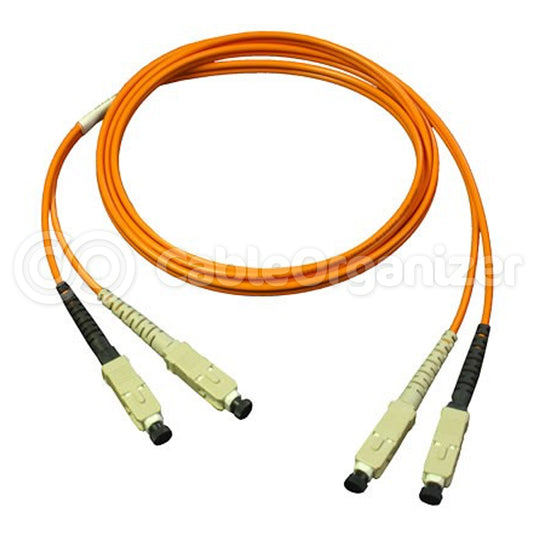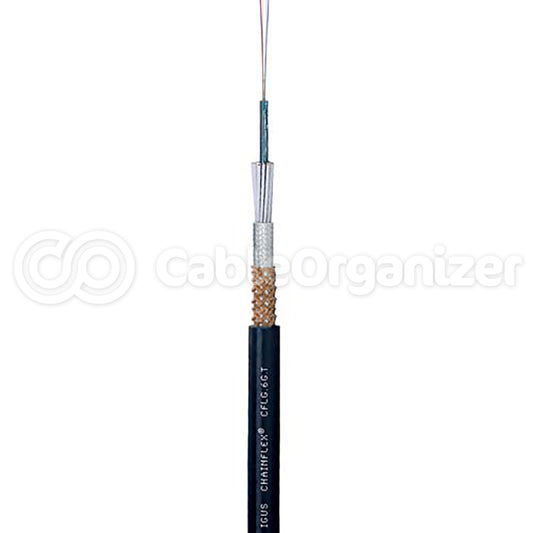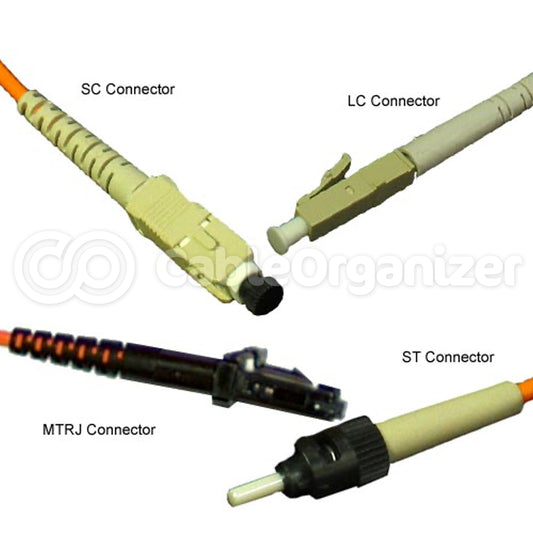Introduction to Fiber Optics
By: CableOrganizer®

The increasing ability to transmit a higher amount of information over longer distances more quickly has expanded the boundaries of our technological development. Data networks, wireless and satellite communications, and cable utilities are among the areas that have experienced this high-tech surge, thanks to the use of fiber optics. These industries will continue to grow, and fiber optics applications expand.
WHAT ARE FIBER OPTICS?
Fiber optics, also known as optical fibers, are microscopic strands of very pure glass with about the same diameter of a human hair. Thousands of these optical fibers are arranged in bundles in optical cables, which are used to transmit light signals over long distances. Each of these bundles are protected by a jacket, which is the cable's outer covering.
The single optical fiber consists of the core which is the thin glass center of the fiber where the light travels. The buffer coating is the plastic coating that protects the fiber from moisture and damage. That coating is additionally the outer optical material that surrounds the core and reflects the light back into it is the cladding.
Singlemode and multimode are the two types of optical fibers. The singlemode type is used for long distances, has small cores, and transmits infrared laser light. The multimode, normally used for short distances, has large cores and transmits infrared light.
FIBER OPTICS VERSUS COPPER
Even though the fiber optic system is like the copper wire system, fiber optics continue to steadily replace copper wires as an appropriate means of communication signal transmission.
Fiber optics are thinner and have a higher carrying capacity than copper, which often makes them more expensive. Optical fibers are well suited for carrying digital information because of the speeds at which they can securely carry data. Copper cables, on the other hand, are often more vulnerable to hackers, while optical fibers are virtually impervious. There's no electricity in fiber optics so the danger of fire is reduced, along with the possibility of electromagnetic interference (EMI). Fiber optic cables are lightweight, take up less space, and are also more flexible.
HISTORY OF FIBER OPTICS
Some historians have erroneously believed earliest optical communications dating back to Roman times were forerunners to the optical fibers we have today. This is because of the use of light in these early communications with signal fires. This way to communicate differed though from the “optical telegraph” system, also known as “semaphore,” which may have been a precursor to the concept of fiber optics. That was demonstrated in the 1790s when the Chappe brothers from France relayed messages from one tower to the next through a series of lights and visual indicators, creating the first known organized optical telegraphy system. The mid-1800s was when the first fiber optic breakthroughs, however, truly began.
FIBER OPTICS DURING THE 1800S
Physicists Daniel Collodon and Jacques Babinet reported in the 1840s light could be directed along jets of water for fountain displays. British physicist John Tyndall demonstrated in 1854 that light could travel through water jets, thereby proving a light signal could be bent.
Alexander Graham Bell patented an optical telephone system in 1880, known as the “photophone,” which assisted in the advancement of optical technology. William Wheeler in that same year invented a system of light pipes that illuminated homes from an electric arch lamp located in the basement.
Two innovators known only as Dr. Roth and Professor Reuss — part of a medical team in Vienna — have been credited in many articles and books for experimenting with bent glass rods in 1888 to illuminate body cavities. Henry Saint-Rene designed a system of bent glass rods to guide light images in an early television scheme in 1895. American David Smith applied for a dental illuminator patent using a curved glass rod in 1898.
FIBER OPTICS MOVE FORWARD IN THE 1900S
The first person to transmit an image of a light bulb filament through a bundle of optical fibers was Heinrich Lamm in 1930. Holger Moller Hansen applied for a Danish patent in 1951 on fiber optic imaging, in which he proposed cladding glass or plastic fibers with a transparent low-index material. He was denied the patent because of previous patents in the 1920s and 1930s. John Logie Baird was a Scottish inventor who became famous for creating the first television in 1926, applying for a patent for transmitting his images using fiber optics. His patent was granted in the United Kingdom in 1928. Electrical engineer Clarence W. Hansell filed an application for RCA in 1927 that was granted in the United States in 1930, for picture transmission using light energy.
An undergraduate student named Larry Curtiss was hired by Basil Hirschowitz and C. Wilbur Peters in 1955 to work on their fiber optic endoscope project. Curtiss made the first glass-clad fibers by rod-in-tube method in 1956. Hirschowitz was the first to test fiber optic endoscope on a patient the following year.
Elias Snitzer of American Optical published a theoretical description of single mode fibers in 1961. The scientists at Corning Glass Works reached their goal of making singlemode fibers with attenuation less then 20dB/km in 1970, achieving this through doping silica glass with titanium.
Bell Laboratories developed a modified chemical vapor deposition process in 1973 that heated chemical vapors and oxygen to form ultra-transparent glass that could be mass-produced into low-loss optical fiber. This process remains the standard for fiber optic cable manufacturing.
The Dorset (UK) police installed the first non-experimental fiber-optic link in 1975, and the first live telephone traffic passed through fiber optic cables in Long Beach, California two years later.
Telephone companies in the late 1970s and early 1980s used great numbers of fibers to rebuild their communications infrastructure. Sprint was founded on the first nationwide 100 percent, fiber optic network during the mid-1980s.
Emmanuel Desurvire and Randy Giles of Bell Laboratories and David Payne of Southampton University invented optical amplifiers in 1991 that were built into the fiber optic cable itself. The all-optic system could carry 100 times more information than cable with electronic amplifiers.
The first all-optic fiber cable called TPC-5, which used optical amplifiers, was laid across the Pacific Ocean in 1996. The Fiber Optic Link Around the Globe (FLAG) became the longest single-cable network in the world in 1997, furnishing the groundwork for the next generation of Internet applications. Dense Wavelength Division Multiplexing (DWDM) was introduced in 1999, which expanded fiber optic networks’ capacity. This technology facilitated one fiber to receive numerous light wavelengths at the same time.
FIBER OPTICS IN THE 2000S
The use of long-haul and undersea fiber optic networks became more commonplace in the early 2000s as internet usage and global connectivity increased. Alcatel-Lucent Bell Labs reached a record transmission rate of 100 terabits per second (Tbps) in 2006, with DWDM. The prominence of high-speed internet and cloud services increased by the 2010s with fiber-to-the-home (FTTH) and fiber-to-the-premises (FTTP). The first major gigabit internet service was Google Fiber in 2012, which was then deployed in select cities. A team at University College in London broke the data transmission rate in 2016, previously set a decade earlier, with the new speed at 1.125 Tbps. Fiber optic networks for 5G technology and the Internet of Things (IoT) continued to expand globally as of the 2020s. The medical, military, telecommunication, industrial, data storage, networking, and broadcast industries implement and use fiber optic technology in a variety of applications today.
Shop for fiber optic cables, testers, and other fiber optic supplies at CableOrganizer®.


